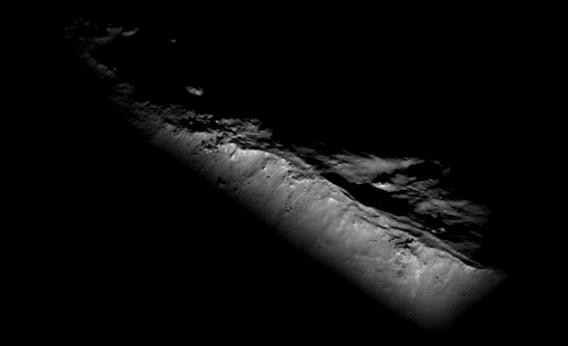Create a free profile to get unlimited access to exclusive videos, sweepstakes, and more!
Sunrise on a Crater Rim

Every now and again, a photograph from a spacecraft stops me dead in my tracks. The shot above is one such image, taken by the wonderful Lunar Reconnaissance Orbiter.
It shows sunrise on the western part of the rim of Jackson Crater, on the far side of the Moon. Jackson is a relatively young crater about 70 km across, with a well-defined rim that extends around it like a single, long rampart bent into a battered circle.
Because the rim rises up from the terrain around it, it’s the first to be lit by the rays of the rising Sun. The Moon spins once every 27 days or so, so sunrise takes 27 times longer than it does on Earth. Here on Earth the Sun takes about two minutes to clear the horizon, so on the Moon it takes roughly an hour.*
What a view that must be! And what magnificent scenery it illuminates. On the Moon, with no atmosphere, there’s no reddish-pink hue to the sky. It’s black all the time, even during the day. When the Sun rises, it must be like a light switch being thrown. Still, the low angle will illuminate the level ground less than something angled up, tilted such that it’s flatter to the incoming rays. So the inside wall of the rim is lit well, the lunar terrain outside the rim still appears somewhat dim, and the inside of the crater is cloaked in inky blackness.
The combination of stark lighting, soft lighting, and no lighting at all is entrancing. The moon is always a beautiful object to see, but it’s the shadows that add to the poetry of the composition. There’s mystery and intrigue in the shadows’ edges.
Another reason this image is so striking is that most LRO shots are “nadir angle,” looking straight down at the surface below the spacecraft. This one was taken at an oblique angle, the better to see contours and shadows (a zoomable map of Jackson using LRO nadir images shows just how different it looks in full sunlight and peering straight down at it). Between its unusual angle and the striking lighting, this image has quickly become one of my favorites from a mission that has provided so many stunning photographs of our cosmic companion.
*Ignoring atmospheric effects (on Earth) and latitude, which can actually change the length of sunset significantly. There’s no air on the Moon, but latitude effects can make the sunrise last for many hours or more near the poles.


























